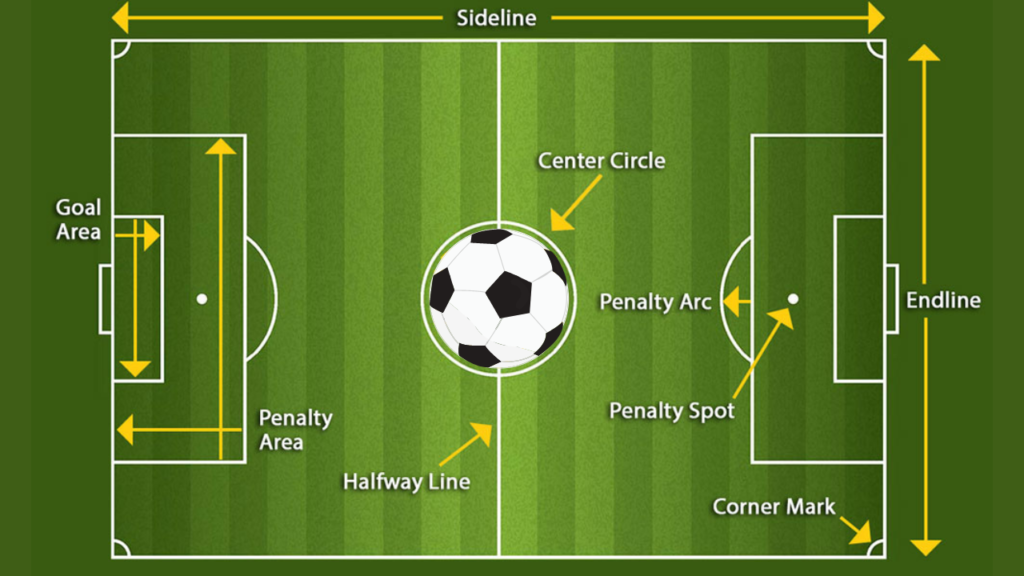- Last Updated -
Comparing the Corners: Soccer Vs Football Field Shapes
Let’s talk a bit about soccer Vs football fields. They’re both places where thrilling games happen, but they’re quite different in their shapes and sizes.
First, picture a soccer field, which is a large rectangle. Its dimensions fluctuate depending on the level of the game, with the length usually ranging between 100-130 yards and the width between 50-100 yards. Interestingly, it doesn’t have what we’d traditionally call corners. Instead, there are these curved lines at each corner, marking the spots for corner kicks.
Now, let’s shift gears to the American football field. It’s a little like a rounded rectangle with a pair of end zones at each end. Typically, it’s about 120 yards long and roughly 53 yards wide. It’s got these longer sidelines compared to a soccer field and hash marks that indicate yardage between plays.
These differences in field shapes and sizes impact how the players move, how strategies are planned, and how tactics are executed during the games. On a soccer field, players typically have to cover a lot more ground since it’s quite a vast playing surface. But on a football field, players generally stick to their assigned areas due to the compact nature of the field.
Whether you’re a fan of soccer or football might depend on your likes or where you come from. But here’s the cool part: understanding these subtle differences between the fields of these two games can deepen your appreciation for both of them!

Let’s delve into the fascinating comparison of soccer and football field sizes
The lengths of these two fields differ. Picture a standard football field – it’s 100 yards long. Now, imagine a soccer field.
It can stretch anywhere from 100 to 130 yards in length. Quite a jump, right? Soccer players might find themselves running more than their football counterparts, which can influence how they perform during a game.
Now, think about the width. Soccer fields take the lead here too, with a typical field being anywhere between 50 and 100 yards wide. On the other hand, a football field is much narrower at about 53.3 yards. This extra room in soccer allows players to spread out, plan strategic plays, and avoid feeling squeezed in. The dimensions of the fields really can change the nature of the game.
With a larger playing surface in soccer, players might find themselves taking more risks and innovating with their passes to advance the ball downfield. Contrastingly, football’s smaller fields facilitate tighter formations and swift plays, leading to potentially large gains in yardage.
While both sports share similarities like goalposts and markings, the difference in size between a standard soccer field and a football field is pretty significant. Your preference for one over the other might hinge on what you love more – the thrill of speed or the art of strategy, the finesse of a well-placed pass, or the power of a touchdown.
A Game of Inches: The Widths of Soccer and Football Fields
Let’s talk about the playing widths of soccer and football fields, as they are quite distinct from each other.
Though soccer and football fields are somewhat similar in length, the width tells a different story. Picture a standard soccer field with a spacious breadth that can reach up to 100 yards. In comparison, the NFL mandates that football fields should not exceed 50 yards in width.
This increased breadth in soccer offers players more room to maneuver, strategize, and create plays along the flanks. Interestingly, soccer doesn’t have the marked out-of-bounds areas that we see on American football fields. This means a ball in soccer can roll out on any side, only to be swiftly brought back into the game with a throw-in from the spot it exited.
Such dynamics require players to be constantly alert and focused, tracking the ball wherever it goes. Furthermore, due to the wider expanse of a soccer field, players have to do a lot more running, demanding a higher level of stamina compared to the more compact football field.
This generous extra space in soccer means players cover more ground during a match, making the game physically challenging. On the flip side, while football players have less ground to cover, they often face more intense physical contact due to the sport’s nature, which unfolds over shorter distances compared to soccer.
Let’s uncover the mystery of the size difference between soccer and football fields
When you compare the two, it’s easy to see that a soccer field is considerably larger than a football field. The reason behind this lies in soccer, a sport that requires a wider playing area for players to dash and weave around.
The rules specify a soccer field to be anywhere between 100-130 yards long and 50-100 yards wide. In contrast, a football field is a standard 100 yards long and approximately 53.3 yards wide. That’s almost a whole acre of difference!
It’s not just the total size; the specific areas within the fields also differ. For instance, a soccer field’s penalty box is considerably larger than a football field’s end zone.
Even the goal area in soccer, although smaller than the end zone, still occupies more space than the typical touchdown area in football. So, why does the size matter, you may ask?
Well, it influences the way the games unfold. More space equals more room for players to move around and craft scoring opportunities. In soccer, the additional room opens up more passing lanes and dribbling opportunities past defenders. In contrast, football’s more compact field makes it easier for defenders to thwart offensive plays and limit scoring chances.
In conclusion, although soccer and football fields do share some similarities like layout and markings, their size differences are striking. These disparities significantly impact how the games are played, calling for distinct strategies from players and teams.

Underfoot and Overlooked: A Close Look at Soccer Vs Football Field Surfaces
Let’s take a moment to peek beneath our feet and consider the surfaces of soccer and football fields, which reveal some notable differences.
Picture a typical soccer field. It’s often cloaked in either natural grass or artificial turf. Now, envision a football field. You’ll likely find it layered with synthetic materials like field turf.
It’s interesting to note that soccer players often favor playing on natural grass. Why? Well, it allows for smoother ball control and movement. The ball simply glides more naturally on grass than on artificial turf, which sometimes results in bounces or direction changes that can feel a bit unpredictable.
Football players, on the other hand, tend to lean towards synthetic surfaces. The reasoning here is that these surfaces provide better traction, which can reduce the risk of injuries. Maintenance is another factor that distinguishes soccer and football field surfaces.
Maintaining a grassy soccer field can be a demanding task. It calls for regular watering, mowing, fertilizing, and aerating, which can add up in terms of costs.
Football fields made of synthetic materials have an edge here—they don’t demand watering or mowing. However, they do need occasional cleaning and resurfacing to ensure they stay in prime condition.
So, even though soccer and football fields might appear similar when you first look at them, the devil’s in the details when it comes to surface construction and maintenance needs.
Your choice between natural grass or synthetic turf could be down to personal preference, as well as the specific requirements of the sport for optimal traction or ball movement.
Let’s take a journey across the lines and markings that distinguish soccer fields from football fields
One thing that strikes you is that soccer fields’ markings are simpler than those on a football field. This isn’t to say that soccer is a simpler sport, but it does have less intricate markings. On a soccer field, you’ll encounter only 10 marking lines: two touchlines on the long sides, two goal lines on the short sides, and the six-yard boxes at both ends of the pitch.
The one remaining mark is the center line, neatly splitting the pitch into two halves. These straightforward markings make it easy for players to navigate the field and help referees make accurate decisions.
Comparatively, football fields sport a greater variety of lines and markers. Apart from the goal lines and sidelines, you’ll find hash marks indicating where each play commences.
Yardage markers dot the sidelines every ten yards, informing players about the distance they need to cover for a first down or touchdown. Then, you’ll see various zones marked off, like end zones and penalty areas that come into play after touchdowns or penalties.
While both sports rely on clear markings to facilitate gameplay, it’s evident that football fields have more intricate markings compared to soccer fields.
This doesn’t make one sport superior to the other – it merely reflects the unique demands of each game that dictate the nature of the playing surface for an optimal gaming experience!
Goalposts Galore: The Key Differences in Soccer and Football Field Goalposts
Let’s take a moment to talk about goalposts. You’d find them on both soccer and football fields, and though they might look quite alike, they do have distinct differences.
In both sports, the aim is to score goals by launching the ball into the opposing team’s goal. But here’s where the differences kick in. Soccer goalposts are smaller and lack a crossbar, while football goalposts are larger and feature a distinct upright crossbar.
Diving into specifics, a soccer goalpost measures 8 feet high by 24 feet wide. They’re usually crafted from materials like aluminum or steel and sport a white paint job for visibility. You won’t find a crossbar here, just two vertical posts extending from the ground. To score in soccer, players have to aim their shot either at these posts or directly above them to make sure the ball goes into the net.
Football goalposts, on the other hand, consist of two vertical posts, like in soccer, but they’re linked at the top by an upright crossbar. This crossbar stands 10 feet off the ground, and the posts are spaced 18 feet apart.
The larger size of football goalposts allows players more room to score points, either by passing or kicking the ball through them. Ever wondered why there’s an extra point attempt after a touchdown in American Football? It’s all thanks to the larger size of these goalposts!

From Grass to Goalposts: Unpacking the Key Differences Between Soccer and Football Fields
Let’s delve into the wonderful world of soccer and football fields, unpacking the key differences that make each of these sports unique. Although both games are played on lush, green fields, the dimensions and markings on these pitches differ quite a bit.
In terms of size, a soccer field trumps a football field. A typical soccer field spans 100-130 yards in length and 50-100 yards in width, giving players plenty of room to run about. On the other hand, a football field comes in at 120 yards long and 53.3 yards wide, making the gameplay a bit more compact. This disparity means that soccer players typically need to cover more ground during a match, demanding top-notch physical fitness.
Moving on to markings, both fields sport distinct lines and zones. A soccer field flaunts sidelines and goal lines marking out the boundaries of the game. You’ll also see specific markings for the center circle, penalty area, and goal box, all crucial for regulating play during a match.
Meanwhile, a football field is adorned with yardage markers every 10 yards to indicate first downs and two end zones for scoring touchdowns.
Let’s not forget the goalposts, another area of difference. In soccer, the goalposts are made of two vertical posts bridged by a horizontal crossbar, placed on either end of the field, with a net attached behind to catch any balls that fly in. American football, on the other hand, employs H-shaped goalposts positioned at each end zone, also coupled with a net.
Despite the common thread of being played on grassy fields, soccer and football take distinct approaches when it comes to marking their playing surfaces and structuring their goals and point systems, all embedded within each sport’s unique rules.
The Adventure of Playing Soccer on a Football Field
Playing soccer on a football field can certainly be an adventure, given the distinctive differences between the two fields. One of the key disparities is the size of the playing surface.
Football fields tend to be shorter and not as wide as soccer fields. While this may pose a challenge for players used to sprawling soccer fields, it also adds an element of excitement to the game. Matches often become faster-paced with the potential for more goal action.
Another twist is the positioning of the goalposts. Unlike soccer fields where the goalposts are situated at the back of each end line, football fields have them placed at the front. Players need to recalibrate their shooting targets, which may initially feel a bit unfamiliar.
Football fields also come adorned with unique markings like hash marks and yard lines, which could add an interesting dynamic to gameplay.
Despite these distinctions, soccer teams often end up playing on football fields due to scheduling constraints or field availability. Adjusting to the varied gameplay and markings might take a little time, but seasoned players usually adapt with practice and familiarity with both types of fields.
Ultimately, while playing soccer on a football field may bring about slight adjustments, it all boils down to how well players adapt and employ their skills in any given situation. With grit, determination, and the ability to flexibly navigate unfamiliar turf or markings, any player can shine and triumph in any match!
See The Table Below For A Quick Comparison:
| Feature | Soccer Field | Football Field |
|---|---|---|
| Length | 100-130 yards (90-120 meters), Avg. 120 yards | 120 yards (110 meters), 100 yards excluding end zones |
| Width | 50-100 yards (45-90 meters), Avg. 75 yards | 53.3 yards (just under 50 meters) |
| Area | 9000 square yards (avg.) | 6396 square yards |
| Length Variation | Varies widely, minimum for international matches is 110 yards | Fixed at 120 yards including end zones |
| Width Variation | Varies widely, minimum for international matches is 70 yards | Fixed at 53.3 yards |
| Field Shape | Rectangular | Rectangular |
| End Zones | N/A | 10 yards on each end |
| Total Playing Area (excluding end zones for football) | 5000-10000 square yards (avg. 9000 square yards) | 5355 square yards (excluding end zones) |
Conclusion
The disparities between a soccer field and a football field are quite notable. Each field’s shape, size, markings, and goalposts are designed uniquely to match the specific requirements of the sport.
Typically, soccer fields are larger than football fields, offering more room for players to maneuver. A soccer field’s length varies from 100 to 130 yards, whereas football fields maintain a fixed length of 100 yards.
Not just the size, but the field shapes also differ. Soccer fields take on a rectangular form, while football fields adopt a more trapezoidal outline, courtesy of the end zones adding extra space at each field’s extremity.
Further, the types of surfaces soccer fields boast vary, influenced by location and weather conditions. The markings on soccer fields, defined for penalty and corner kicks, also stand distinct from those on football fields.
The positioning of goalposts in the two sports contrasts as well. In soccer, goalposts are situated on either side of the goal line at the field’s ends, while in football, they stand behind each end zone.
All these variations underscore the unique characteristics each sport’s field brings to the game. Even though both sports involve the shared goal of scoring, the differences in their field setups significantly influence the game’s dynamics and strategies.
Whether you’re a soccer enthusiast, a football fan, or someone who equally relishes both sports, it’s these unique aspects that lend each game its charm and excitement.
FAQs
Q. What is the size difference between a soccer field and a football field?
- A soccer field is generally larger than a football field. The dimensions of a soccer field can range from 50-100 yards in width and 100-130 yards in length, according to FIFA regulations. On the other hand, an American football field has fixed dimensions of 53.3 yards in width and 120 yards in length, including the end zones.
Q. Are the sizes of soccer fields and football fields fixed?
- The size of an American football field is fixed, with a length of 120 yards (including the end zones) and a width of 53.3 yards. However, the size of a soccer field can vary. FIFA regulations state that a soccer field’s dimensions can range from 50-100 yards in width and 100-130 yards in length.
Q. What are the dimensions of a soccer field in the American Soccer League (MLS)?
- The Major League Soccer (MLS) recommends the length of a soccer field to be 110 yards and the width to be 70 yards. However, the actual dimensions can vary as long as they fall within the FIFA regulations.
Q. How do the end zones affect the length of a football field?
- The end zones in a football field significantly affect its length. Each end zone in a football field is 10 yards deep, adding an extra 20 yards to the overall length of the field. This means that while the length from the goal line to the goal line is 100 yards, the total length of a football field including the end zones is 120 yards.
Q. Why is a soccer field larger than a football field?
- A soccer field is larger than a football field primarily because the rules of soccer allow for a wider field. A football field is restricted to being only 53.3 yards wide, whereas a soccer field can be up to 100 yards wide. This gives a soccer field a much greater surface area than a football field.
Q. Are there any exceptions to these general size rules for soccer and football fields?
- Yes, there are exceptions. For soccer, the field size can vary depending on the level of play. For instance, youth soccer fields are smaller than professional ones. For football, the field size is generally fixed, but variations can occur in non-professional or informal games.
Concussion Substitutions in Soccer: evolving concussion protocols
The Growing Concern for Player Safety in Soccer Soccer, a beloved sport...
Read More


















